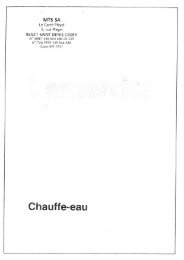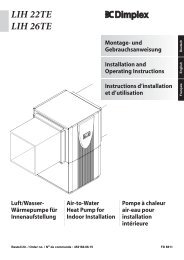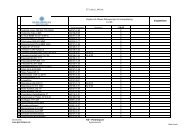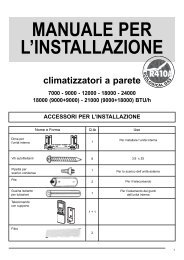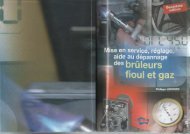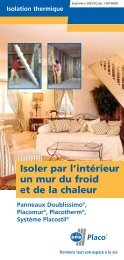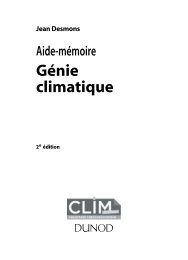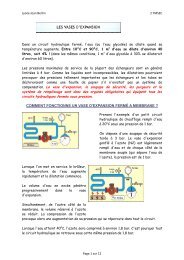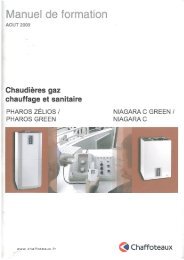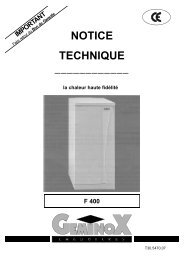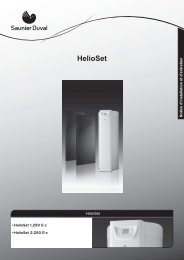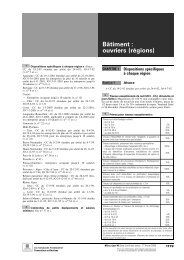F 74 C / FK 74 C FN 74 C / FKN 74 C - enrdd.com
F 74 C / FK 74 C FN 74 C / FKN 74 C - enrdd.com
F 74 C / FK 74 C FN 74 C / FKN 74 C - enrdd.com
You also want an ePaper? Increase the reach of your titles
YUMPU automatically turns print PDFs into web optimized ePapers that Google loves.
Foreword<br />
Although illustrations of type <strong>FK</strong> <strong>74</strong> C are shown<br />
throughout these installation instructions, the details<br />
given apply for all patterns <strong>FK</strong> <strong>74</strong> C, <strong>FK</strong>N <strong>74</strong> C and<br />
F <strong>74</strong> C, <strong>FN</strong> <strong>74</strong> C unless specifically indicated.<br />
1. Installation<br />
It is necessary during installation to observe codes<br />
of good practice, to <strong>com</strong>ply with local requirements<br />
and to follow the installation instructions. The<br />
installation location should be protected against<br />
frost and be easily accessible. Isolating valves<br />
should be fitted on both sides of the filter or filter<br />
<strong>com</strong>bination.<br />
1.1 Assembly<br />
1. Flush pipework thoroughly.<br />
2. Install the flange connection in the pipework<br />
(F <strong>74</strong> C and <strong>FK</strong> <strong>74</strong> C only)<br />
● Ensure correct flow direction as indicated by<br />
arrow<br />
● Install in horizontal or vertical pipework<br />
● Install free of bending or twisting stress<br />
When connecting to an existing flange of<br />
another make (E.g. Cillit) ensure that the<br />
inlet flow is through the outer ring of holes. If<br />
this is not so, the whole connection piece<br />
must be installed the other way round, even<br />
if the arrow does not then indicate the actual<br />
flow direction. If the flange is threaded, the<br />
threaded holes must be drilled out to a<br />
diameter of 6.3 mm.<br />
3. Fit filter or filter <strong>com</strong>bination with the seal<br />
supplied<br />
● Install with filter bowl downwards.<br />
4. Screw in drain connection 3 hand tight.<br />
1.2 Reverse rinse water drainage<br />
The reverse rinse quantity at 4.0 bar operating<br />
pressure for a duration of 15 seconds is<br />
approximately 25 litres. The reverse rinse water<br />
must be piped to the drain in such a way that no<br />
back pressure can occur.<br />
To ensure this, there are three possibilities:<br />
1. Direct connection to drainage pipework<br />
☞ A 70 mm / 50 mm reducing connector is<br />
required to link the 70 mm drain pipe to the<br />
50 mm outlet connection from the filter.<br />
2. Free discharge into existing floor drain.<br />
3. Discharge into an open container.<br />
GB<br />
4<br />
2. Setting outlet pressure<br />
(<strong>FK</strong> <strong>74</strong> C and <strong>FK</strong>N <strong>74</strong> C only)<br />
1. Close valve 1 .<br />
2. Relieve pressure from pipework between<br />
valves 1 and 2 (E.g. through an outlet valve<br />
or vent).<br />
3. Loosen slotted screw 4<br />
● But do not remove <strong>com</strong>pletely.<br />
4. Slacken adjustment spring by turning the<br />
setting knob anti-clockwise.<br />
5. Close valve 2 .<br />
6. Slowly open valve 1 .<br />
7. Set to the required outlet pressure by turning<br />
the setting knob. Turning clockwise increases<br />
the set pressure. Turning anti-clockwise<br />
reduces the set pressure. (Check value on<br />
pressure gauge).<br />
☞ If the pressure is to be set to a lower value,<br />
the outlet pressure must first be relieved to<br />
achieve the required setting.<br />
8. Retighten slotted screw 4 .<br />
9. Slowly open valve 2 .<br />
3. Reverse rinsing<br />
An inlet pressure of at least 1.5 bar is required<br />
for reverse rinsing. The reverse rinsing interval is<br />
dependent on the degree of contamination of the<br />
water. DIN 1988, Part 8 requires that the reverse<br />
rinsing interval shall be no longer than every two<br />
months. Local country requirements have to be<br />
respected.<br />
To ensure that convenient and regular reverse<br />
rinsing takes place, we re<strong>com</strong>mend that a Z <strong>74</strong> A<br />
automatic reverse rinse actuator be fitted.<br />
3.1 Manual reverse rinsing<br />
If reverse rinsing is not via a direct drainage<br />
connection, then a suitable container must<br />
first be put underneath.<br />
1. Open the ball valve by turning the reverse<br />
rinse knob until it reaches stops.<br />
● Indicator bar must be vertical<br />
● The patented reverse rinsing system will<br />
start operating<br />
● Filtered water can be drawn during reverse<br />
rinsing.<br />
2. Close the ball valve after approximately<br />
15 seconds.<br />
● A longer reverse rinse period may be<br />
necessary if the filter is very dirty.<br />
The date of the next scheduled reverse rinsing<br />
can be marked using the memory ring.<br />
3.2 Automatic reverse rinsing with the Z <strong>74</strong> A<br />
The Z <strong>74</strong> A automatic reverse rinse actuator is<br />
available as an accessory. The actuator<br />
automatically controls reverse rinsing at any<br />
preset interval between 4 minutes and 3 months.<br />
4. Maintenance<br />
Planned maintenance is re<strong>com</strong>mended<br />
(in line with DIN 1988, part 8).<br />
4.1 Inspection of the pressure reducing valve<br />
( <strong>FK</strong> <strong>74</strong> C and <strong>FK</strong>N <strong>74</strong> C only)<br />
By the user or a specialist:<br />
1. Close valve 2 .<br />
2. Check the set outlet pressure with a pressure<br />
gauge at zero flow. The pressure must not rise.<br />
If the pressure does not remain stable and<br />
slowly rises, the valve seat must be inspected<br />
as described in "Pressure reducing valve<br />
service (4.2)" and if necessary be replaced.<br />
3. Slowly open valve 2 .<br />
4.2 Pressure reducing valve maintenance<br />
(<strong>FK</strong> <strong>74</strong> C and <strong>FK</strong>N <strong>74</strong> C only)<br />
By a specialist:<br />
The time interval depends on the local operating<br />
conditions (DIN 1988 specifies 1 to 3 years).<br />
1. Close valve 1 .<br />
2. Relieve pressure between valves 1 and 2<br />
(e.g. with vent).<br />
3. Loosen slotted screw 4<br />
● Do not remove <strong>com</strong>pletely.<br />
4. Slacken adjustment spring by turning setting<br />
knob anti-clockwise.<br />
5. Close valve 2 .<br />
6. Unscrew spring bonnet<br />
● Use double ring wrench ZR 10-3 /4 supplied.<br />
7. Remove slip ring 5 .<br />
8. Remove valve insert by pulling the valve stem<br />
with pliers.<br />
9. Check that seal washer 6 and rim 7 are in<br />
good condition and if necessary replace<br />
<strong>com</strong>pletely with valve insert D 06 FA-1B.<br />
10.Assemble in reverse order<br />
● Press in diaphragm with finger and then<br />
insert slip ring (check for correct<br />
positioning).<br />
11.Set the outlet pressure by turning the setting<br />
knob (see section 2).<br />
GB<br />
5<br />
4.3 Filter<br />
● The filter must be cleaned regularly by<br />
reverse rinsing and at intervals of no longer<br />
than two months.<br />
- This operation can be carried out by the<br />
user.<br />
● Filter can be<strong>com</strong>e blocked if this is not done,<br />
resulting in pressure drop and falling flow<br />
rate.<br />
● The filters are stainless steel. Red rust<br />
deposits from the pipework have no effect<br />
on function and filter operation.<br />
4.4 Pressure gauge<br />
To remove the pressure gauge, first raise the<br />
blue cover fully until it reaches stops.<br />
5. Applications<br />
Water up to 30 °C<br />
Operating pressure min. 1.5 bar<br />
max. 16.0 bar<br />
Do not use any cleaning materials containing<br />
solvents for cleaning plastic parts.<br />
Filters must not be installed in locations where<br />
ultra violet rays (sunlight) or solvent fumes are<br />
present.<br />
6. Safety guidelines<br />
1. Use the appliance<br />
● In good condition<br />
● According to regulations<br />
● With due regard to safety.<br />
2. Follow installation instructions<br />
3. Immediately rectify any malfunctions which<br />
may influence safety.<br />
4. The F <strong>74</strong> C / <strong>FN</strong> <strong>74</strong> C and the filter <strong>com</strong>binations<br />
<strong>FK</strong> <strong>74</strong> C / <strong>FK</strong>N <strong>74</strong> C are exclusively for<br />
use for applications detailed in these<br />
installation instructions. Any variation from this<br />
or other use will not <strong>com</strong>ply with requirements.<br />
5. All assembly work must be carried out by<br />
authorised specialists.<br />
7. Exchange parts and<br />
accessories<br />
(See page 16)<br />
“



